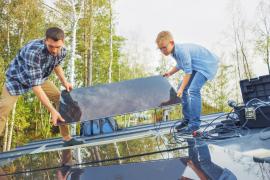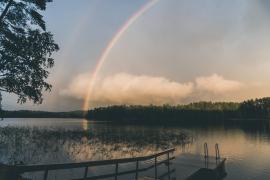What's stopping your camp from improving its existing programs or introducing new ones? At the same time, what's standing between your organization and "going green?" Each to its own extent, cost, culture, and commitment drive the decisions that shape camp whether you're considering programs, facilities, administration, or being greener. This month we're going to see that camps can tackle green initiatives the very same way that they've overcome program obstacles for years and years and years.
Often, the biggest hurdle to something new is simply its newness. The age-old argument about "We never needed it before, so why do we need it now?" seems to go out almost as soon as a new idea begins to gain momentum. If camp professionals were the quitting type, nothing would have changed in the past 150 years of camping. Let's look at how changes, large and small, clear that hurdle.
The critical step to overcoming initial resistance lies with the simple three letter question "W-H-Y"? Unless and until that question is answered to satisfy naysayers, changes will hit an unending string of mysteriously unmovable road blocks. Moreover, in answering that simple question, success is defined and the target is set by default. So think about the last brand-new program that was introduced or even the last program that was overhauled successfully. How was the WHY question addressed? For the sake of our discussion this month, let's use a pretty simple hypothetical situation with swimming lessons as the object. Lots of camps have and continue to struggle with swimming in open lakes versus building a swimming pool. The shift from one to another hinges completely with answering the WHY question to the satisfaction of whoever will be signing the checks to build, operate, and maintain the pool. Clearly, those camps which end up with a pool have made their argument sufficiently well to spring the hundreds of thousands of dollars required.
We can make a similar argument for any sort of green initiative. But for these, it's even more important to answer the WHY question, because as you'll see shortly, there are even more difficult issues ahead that simply cannot be answered until it's well understood WHY we're going to any trouble at all.
So what are the answers to the WHY questions about green efforts? Like answering "why" about camper program changes or additions, these are matters of the heart that must come to life through camp's culture. If camp is situated on a lake, competent swimming skills are more than a program option; they are a critical matter of the safety and perhaps survival of its guests and staff. If for some reason, the water in the lake became unsuitable for swimming much of the time (coliforms in the water, perhaps), the need to be a competent swimmer wouldn't go away, but the need to acquire those skills would simply need to be shifted to another venue. That's camp culture at work, developing those skills that represent life at this facility. No camp exists without clean air, water, and program areas that are safe and clean. So the camp culture from the top to the bottom should be individually and collectively committed to caring for the natural and irreplaceable features of the property, including the land, water (above and below ground), and air. We're talking about caring for those things which aren't personal possessions but are simply on loan for our benefit and use while we're present. This is the quintessential definition of stewardship. On its face, making a case for stewardship doesn't seem too hard. But who among us hasn't wondered if we got the message through to a graffiti-writing camper or the finance committee wrestling with committing a boatload of money to the stormwater management facilities that came with the new parking lot? That brings around the second element of the triad: commitment.
A number of years back, an interesting situation unfolded in a series of posts on one of the camping kindred's Web sites. Apparently, someone had purchased an inflatable iceberg or trampoline for their lake at a reduced price at a conference. It was being shipped directly to camp and was expected to arrive momentarily. The purchaser was posting all sorts of questions about insurance costs, installation procedures, and maintenance. Oh, yeah, and what about permits? Everyone has made shortsighted purchases, but the scope of this situation really made it stand out. Assuming that this item fit the program perfectly, there had been apparently no thought about the commitment necessary to implement, operate, maintain, or sustain it.
How often do we see "green" programs with a similar level of poor planning where a really cool this-or-that is brought from Camp Wherever, but which ultimately fall short? Consider a pretty well-known program common in camp dining halls, the ORT Report. For the unfamiliar, all food scraps are collected from campers' plates at the end of each meal and the weight is recorded and charted over a period of time. The idea is to get campers to eat what they take and take only what they'll eat. (My mom called that the "clean plate club.") Often the waste still goes into the trash. Only once have I been where the food scraps were separated before being weighed (vegetable and milk/meat/dairy) for composting of the vegetable scraps for the camp garden, and feeding a hog with the rest. It's a small distinction, perhaps, but it's an important illustration of how far commitment to the program can be taken with only a small amount of planning, care, and effort. What's really required here? Knowledge that composting only works well with vegetable matter, that you'll need a second scrap bucket, and you'll need a critter to consume the meat and milk waste. Oh yes! One more thing: a bit more money!
The third leg of the proverbial stool is cost. Just like this is often the deal breaker for new or revamped programs, this can be the death knell for a green initiative for a couple of reasons. Depending on how ambitious they are, green efforts can have a pretty daunting initial cost, and it can be nearly impossible to directly associate the time and effort spent with any material benefit to the camper. Unlike archery, individual growth here isn't as much of a skill set that can be demonstrated, as it is new values that could take months or years to really manifest. A delayed "return on an investment" may be tough to justify when every camper's tuition really counts. Delayed returns can be even more dramatic when considering green efforts that don't connect directly into the formal programs but that are simply stewardship necessities. Let's go back to the lake versus pool debate.
Doing what you can to make safe, healthy campers who are able to return next year is like money in the bank; not only don't near-drowned campers come back, their friends' parents don't let their buddies return either. So making sure that your guests can swim if they fall into the lake is a smart investment in camper safety and therefore in the lifeblood of camp. An expense has become an investment.
The analogy for green programs can be a little more difficult to make, but certainly not impossible or even farfetched. We'll continue to use the lake as the object of the discussion. There are very, very few brand-new camps being built, making most camp facilities decades old at best. Surface water usually runs unchecked from parking areas, roofs, and roadways to the lowest topographic features, camps' streams and lakes. Each runoff event (including rain and snow melt) delivers toxins and pollutants to the lake, including lubricants, coolant, and fuels dripped from vehicles, waste including wrappers and litter from the canteen, soil sediment from bare or washed areas, and excess fertilizer from conditioning the athletic fields. All of these contribute in a small way to reshape the physical properties of the lake. Even the pH, the temperature, and the very chemistry of the lake change over time, creating conditions which allow an ever narrowing slice of aquatic life to exist.
Can you canoe on a lake choked with algae and so low in oxygen that almost no fish survive? Absolutely! But why would you want to?
And now we've come full circle, from culture, to commitment, to cost and now back to culture. So it seems that this is indeed a cycle, where the beginning and end are the culture of your camp and therein rests the answer to the question we were after in the first place: WHY should we undertake green initiatives? It can't be to reap government assistance for this or that program, because budgets dry up over time. It can't be to answer a siren call for a years-away global catastrophe wrapped in politics today. It can't be to gain notoriety and collect accolades for a wall or mantle, because those collect dust and are eventually forgotten as well. It's because we owe it to the folks we've chosen to serve. With time and care, they'll take our place and eventually carry this torch forward. Perhaps by then, technology will have advanced to the point where small wind turbines are efficient enough to literally pay us to use them. If we do not do today what we can, simply because it's the right thing to do, where will they practice what we've preached?
"Why?" Because it's what a steward does. That's why! From here, the rest is easy.
Rick Stryker is a professional engineer with a passion for helping camps solve their infrastructure issues through careful planning, crisis management, and education. He can be reached at 570-828-4004 or by e-mail at [email protected].
Originally published in the 2010 July/August issue of Camping Magazine.



